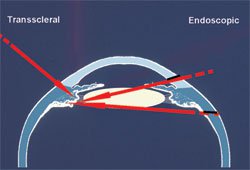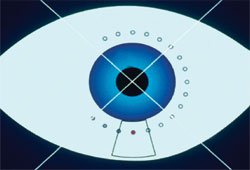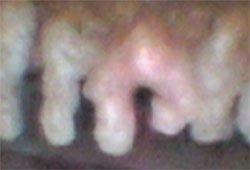Cyclophotocoagulation helpful in treatment of refractory glaucoma
Transscleral cyclophotocoagulation is the more widely used procedure, but an endoscopic approach is also an option.
Transscleral cyclophotocoagulation is a practical, generally well-tolerated, noninvasive procedure for management of refractory glaucoma, according to a review of recent studies.
The transscleral technique is the most widely used and best-studied technique for ciliary body destruction to reduce aqueous humor production and IOP in end-stage glaucoma, said Neeru Gupta, MD, PhD, FRCSC, DABO, at the 2004 American Academy of Ophthalmology meeting. Dr. Gupta is director of the glaucoma unit at St. Michael’s Hospital, University of Toronto.
A less commonly used technique for cyclodestruction is endoscopic cyclophotocoagulation, an invasive approach that requires more time and surgeon training, Dr. Gupta said in an interview with Ocular Surgery News.
She described the current standard approaches to transscleral and endoscopic cyclophotocoagulation in her presentation. Of the two techniques, the transscleral procedure is more thoroughly studied, she said, with multiple retrospective and prospective studies available.
|
|
|
Transscleral approach
Transscleral cyclophotocoagulation can be performed with either an Nd:YAG or a diode laser, Dr. Gupta said. The results with the YAG are comparable to those with the diode laser, as demonstrated in a prospective randomized clinical study by Youn and colleagues in 1998.
The diode laser used for transscleral cyclophotocoagulation has a wavelength of 810 nm, delivered through a contact probe. The advantages of the diode laser include its ease of delivery, small size, portability, standard power outlet requirement and low maintenance costs, she said.
In the more than 100 studies that Dr. Gupta reviewed, the transscleral diode laser appeared to be generally well tolerated, and overall, two-thirds of treated eyes showed successful lowering of IOP and retention of visual acuity, she said.
The transscleral approach also has limitations, she noted.
“The surgeon is unable to visualize the target structure of the tissue, which can lead to skipped areas and frequent re-treatments,” Dr. Gupta said. There is also potential for damaging surrounding tissue, and there is an unpredictable dose-response association, she added.
The most common complication associated with transscleral cyclophotocoagulation is transient inflammation for less than 2 weeks. Less common complaints include pain, severe uveitis, vision loss of more than two lines, chronic hypotony, graft failure and rare reports of vitreous hemorrhage, retinal detachment, severe pain and sympathetic ophthalmia, Dr. Gupta said.
The Nd:YAG laser can also be used in the transscleral approach. The benefits of the YAG laser include a long history of clinical experience, Dr. Gupta noted. The 1064-nm wavelength laser can deliver treatment with both contact and noncontact delivery.
Both the diode and YAG laser procedures can be done in an outpatient setting under local anesthesia, Dr. Gupta said.
Endoscopic approach
|
|
Dr. Gupta said endoscopic cyclophotocoagulation also uses an 810-nm diode laser. The laser is combined with an endoscope in a triple-function probe that allows viewing and treatment of the ciliary processes during this intraocular procedure, she explained.
“Endoscopic cyclophotocoagulation is performed in an operating room setting under local anesthesia,” Dr. Gupta said. Fewer studies have been published on the technique. However, the largest retrospective study by Chen and colleagues in 1997 with 68 patients reported a success rate of 94% at 1 year and 84% at 2 years.
The limitations of the endoscopic approach include that it is an intraocular procedure that requires resources such as an operating room facility with supporting medical personnel, more time and a greater degree of training by the surgeon due to its relatively steep learning curve, Dr. Gupta said.
The advantage of this approach is that the surgeon can directly visualize the target tissue with minimal damage to the surrounding tissue, Dr. Gupta said. Therefore there is a potential for fewer re-treatments and theoretically fewer complications. Endoscopic cyclophotocoagulation can also be combined with other intraocular surgeries such as vitrectomy, she noted.
Potential complications of the endoscopic procedure are similar to those with the transscleral approach, with an additional risk of endophthalmitis and the risks inherent to incisional surgery, she said.
For Your Information:
- Neeru Gupta, MD, PhD, FRCSC, DABO, can be reached at St. Michael’s Hospital, Glaucoma Unit, Cardinal Carter Wing, 30 Bond St., Suite 7-183, Toronto ON M5B 1W8, Canada; +1-416-864-5444; fax: +1-416-864-5208; e-mail: guptan@smh.toronto.on.ca.
- Kim Norton is an OSN Correspondent based in Mt. Laurel, New Jersey.



